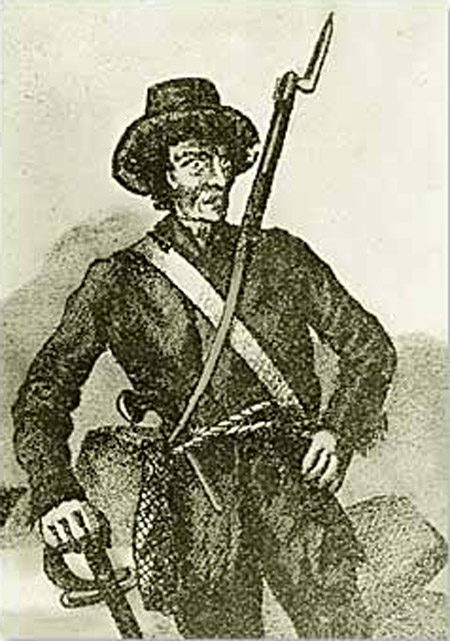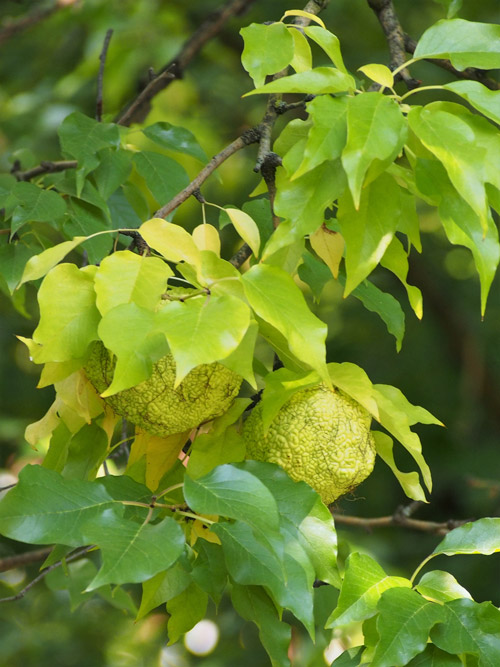Lewis sends the president Osage orange cuttings from Pierre Chouteau‘s garden along with a jackrabbit specimen. In one of the Indian camps near the mouth of the Missouri, Clark meets Simon Girty, an infamous American traitor. In Washington City, President Jefferson Thomas signs a bill dividing the Louisiana Territory recently purchased from France into two jurisdictions.
Simon Girty was a liaison between British forces and their Indian allies during the American Revolution. His reputation was that of a deserter and traitor and was often called “the White Savage.” Many argue that much of his infamy was due to public sensationalism. Clark’s matter-of-fact reporting of this encounter supports the latter.
Simon Girty
I visit the Indian Camps, In one Camp found 3 Squars & 3 young ones, another 1 girl & a boy in a 3rd Simon Girtey & two other familey— Girtey has the Rhumertism verry bad those Indians visit me in their turn, & as usial ask for Something I give them flour &c.
—William Clark
Organizing the Louisiana Territory
On this date, President Thomas Jefferson signs into law the act to create the Orleans Territory and the Louisiana District.
An Act for the Organization of Orleans Territory and the Louisiana District
Be it enacted by the Senate and House of Representatives of the United States of America, in Congress assembled, That all that portion of country ceded by France to the United States, under the name of Louisiana, which lies south of the Mississippi territory, and of an east and west line to commence on the Mississippi river, at the thirty third degree of North Latitude, and to extend west to the western boundary of the said cession, shall constitute a territory of the United States, under the name of the territory of Orleans, the government whereof shall be organised and administered as follows:
The executive power shall be vested in a governor, who shall reside in the said territory, and hold his office during the term of three years, unless sooner removed by the President of the United States.
The executive power now vested in the governor of the Indiana territory, shall extend to, and be exercised in the said District of Louisiana. The governor and judges of the Indiana territory shall have power to establish, in the said District of Louisiana, inferior courts . . .
The President of the United States is hereby authorised to stipulate with any Indian tribes owning lands on the east side of the Mississippi, and residing thereon, for an exchange of lands, the property of the United States, on the west side of the Mississippi, in case the said tribes shall remove and settle thereon . . . .
Nathl. Macon Speaker of the House of Representatives.
Jesse Franklin President of the Senate, pro tempore.March 26. 1804.
Approved
Th: Jefferson[1]Clarence E. Carter, The Territorial Papers of the United States (Washington, DC: United States Government Printing Office, 1948), 202–13, digitized by Google books.
Plumbs and Osage Oranges
St. Louis March 26th 1804.
Dear Sir,
I send you herewith inclosed, some slips of the Osages Plums, and Apples. I fear the season is too far advanced for their success . . . I would thank you to send a part of them to Messrs. John Mason, & William Hamilton. Should they not succeed, Mr. Gratiot can obtain the young plants at the proper season, and send them very readily to Mr. Trist if requested to do so. I obtained the cuttings, now sent you, from the garden of Mr. Peter Choteau [Pierre Chouteau], who resided the greater portion of his time for many years with the Osage nation.
. . . .
MERIWETHER LEWIS
Capt. 1st U.S. Infty.[2]Lewis to Jefferson. Donald Jackson, ed. Letters of the Lewis and Clark Expedition with Related Documents: 1783-1854, 2nd ed. (Urbana: University of Illinois Press, 1978), 170.
White-tailed Jackrabbit
St. Louis March 26th 1804.
Dear Sir,
. . . .
This large hare of America, is found on the upper part of the Arkansas River, and in the country lying from thence South, and West, to the mountains which seperate us from New Mexico, it is said to be remakably fleet, and hard to be overtaken on horseback even in their open plains. I have the honor to be with sincere esteem Your Obt. Servt.
MERIWETHER LEWIS
Capt. 1st U.S. Infty.[3]Ibid., 171.
Weather Diary
Therm at rise
weather wind Therm at 4 Oclk weather wind River 36 above 0 fair E 52 above 0 fair E rise 10 in. the weather worm and fair
—Meriwether Lewis and William Clark[4]To assist the reader, the editor of this web page has omitted the date column, merged the “River” columns, and spelled out some abbreviations.
Experience the Lewis and Clark Trail
The Lewis and Clark Trail Experience—our sister site at lewisandclark.travel—connects the world to people and places on the Lewis and Clark Trail.
Plan a trip related to March 26, 1804:

Winter Camp at Wood River (Camp Dubois) is a High Potential Historic Site along the Lewis and Clark National Historic Trail managed by the U.S. National Park Service. The site, near Hartford, Illinois, is managed as Lewis and Clark State Historic Site and is open to the public.
In present St. Louis, the Jefferson National Expansion Memorial “commemorates Thomas Jefferson’s vision of the continental expansion of the United States” and is a High Potential Historic Site along the Lewis and Clark National Historic Trail managed by the U.S. National Park Service.
Notes
| ↑1 | Clarence E. Carter, The Territorial Papers of the United States (Washington, DC: United States Government Printing Office, 1948), 202–13, digitized by Google books. |
|---|---|
| ↑2 | Lewis to Jefferson. Donald Jackson, ed. Letters of the Lewis and Clark Expedition with Related Documents: 1783-1854, 2nd ed. (Urbana: University of Illinois Press, 1978), 170. |
| ↑3 | Ibid., 171. |
| ↑4 | To assist the reader, the editor of this web page has omitted the date column, merged the “River” columns, and spelled out some abbreviations. |




